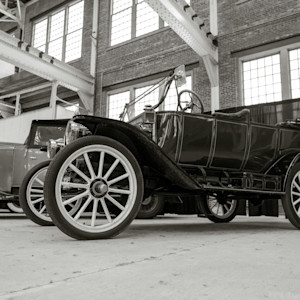All About the Ford Model T

Few machines have changed everyday life as much as the Ford Model T. Launched in 1908 and produced through 1927, the "Tin Lizzie" put reliable motor travel within reach of working families, reshaped American industry and helped pave the way for modern mobility.
Characteristics and Design
The Model T was intentionally designed to be sturdy and straightforward. Its 177-cubic-inch (2.9 L) inline four-cylinder engine produced about 20 horsepower (enough for up to 45 mph on good roads) and was famous for shrugging off abuse.
Early cars were hand-cranked to start, with electric starters only becoming available later in the run. A magneto ignition kept the system rugged and reduced dependence on a separate battery, which mattered in an era when rural electrification was spotty.
Instead of a conventional gear lever, the T used a planetary transmission operated by three pedals and a hand lever. The left pedal controlled low, neutral and high gears; the center pedal was for reverse; and the right pedal activated the transmission brake.
The throttle and spark advance were on levers beneath the steering wheel. It sounds alien today, but this layout made low-speed maneuvering on rough ground straightforward and remarkably intuitive once drivers got the hang of it.
Underneath, the Model T rode on transverse leaf springs, front and rear, with beam axles that were strong, inexpensive and tolerant of terrible surfaces. Its chassis used vanadium steel for a high strength-to-weight ratio, and the 100-inch wheelbase balanced stability with agility.
The wheels started as wooden artillery-type wheels, with balloon tires arriving in the mid-1920s to soften the ride. Braking was basic by modern standards: a band brake in the transmission and a separate hand brake for parking, with period aftermarket kits adding drum "outside brakes" for more stopping power. A gravity-feed fuel tank sat beneath the front seat and the engine doubled as a stationary power plant via a belt pulley when farmers needed to run saws, pumps or threshers.
Owners routinely customized their Model Ts into snowmobiles, delivery vans, fire engines and even field tractors with bolt-on conversion kits. The same durability that made the Model T a family car turned it into a Swiss Army knife for rural America.
Production
The assembly line is what made it possible for the Model T to have such a huge impact. In 1913, Ford's Highland Park, Michigan, plant synchronized parts, processes and worker motion so efficiently that full vehicle build time fell from more than 12 hours to roughly 90 minutes.
Interchangeable parts and specialized stations allowed relatively unskilled workers to achieve consistent quality at an astonishing speed. This drove vehicle prices down.
Early runabouts cost hundreds more than later cars; by the mid-1920s, a new Model T could be had for a fraction of its original price, putting ownership within reach of clerks, machinists and teachers. The Model T's annual output climbed into the millions, and total production exceeded 15 million vehicles.
But the ideas that made the Model T dominant also made it vulnerable. Henry Ford's philosophy of "get it right and keep it the same" kept costs low, but competitors wooed buyers with fresh styling, quieter engines, and features the Model T lacked. In 1927, Ford paused U.S. production, retooled and returned with the more modern Model A.
Advertising and Marketing
Ford didn't rely on glossy, aspirational ads as much as it did on ubiquity and word of mouth. A vast dealer network meant that a Model T was always nearby to test and buy. Local showings, road demonstrations and community clubs turned the novelty of automobiling into a social experience.
Ford's publicity machine also leaned into utility. Farmers saw the Model T as a machine to power equipment and haul loads; small businesses saw a delivery truck; and municipalities bought fleets for police and firefighters.
The color of Model T's became a cultural talking point. Early Model T's came in several hues; during peak mass production, black dominated because it was economical, durable with the paint technology of the era, and suited to the high-throughput paint processes then available.
The line "any color so long as it's black" became part of American folklore, half slogan, half myth-making, reinforcing the message that practicality, not frills, delivered value.
Additional Resources
- On the Road in 1912: The Model T
- Henry Ford's Model T Hits the Market
- The Model T Put the World on Wheels
- How a 100-Year-Old Car Theft Law Led to the Modern FBI
- On the Right Side of the Road: The Model T's Influence on Driving
- The 15 Millionth Ford Model T Rolls off the Assembly Line
- "Henry's Made a Lady Out of Lizzie"
- Ford Model T: Lessons for Product Platforming
- Florida Driver Education Course
- The Ford Model T Roadster
- Getting Your Permit in Florida
- Model T Ford Snowbird
- Ford Topedo Runabout Model T
- Ohio Teen Driver Education
- The Model T's Design
- Virginia Driver Training
- Roads, Model T's, Tourists, and Tea Rooms

